Page 4325 of 5598
SBC-28
< WIRING DIAGRAM >
SEAT BELT WARNING SYSTEM
JCHWM0723GB
Revision: 2010 May2011 QX56
Page 4326 of 5598
SEAT BELT WARNING SYSTEMSBC-29
< WIRING DIAGRAM >
C
DE
F
G
I
J
K L
M A
B
SBC
N
O P
JCHWM0724GB
Revision: 2010 May2011 QX56
Page 4327 of 5598
SBC-30
< WIRING DIAGRAM >
SEAT BELT WARNING SYSTEM
JCHWM0725GB
Revision: 2010 May2011 QX56
Page 4329 of 5598
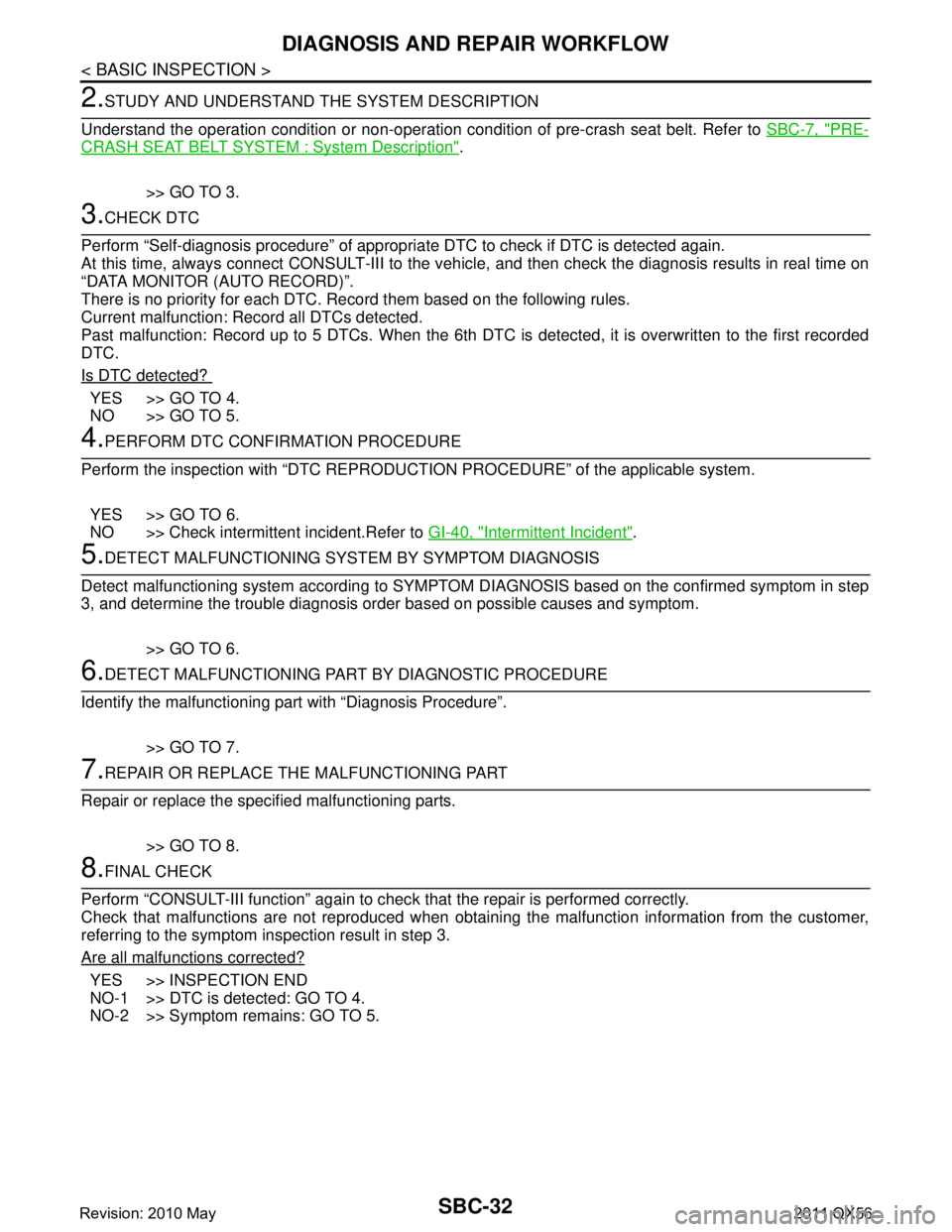
SBC-32
< BASIC INSPECTION >
DIAGNOSIS AND REPAIR WORKFLOW
2.STUDY AND UNDERSTAND THE SYSTEM DESCRIPTION
Understand the operation condition or non-operation c ondition of pre-crash seat belt. Refer to SBC-7, "
PRE-
CRASH SEAT BELT SYSTEM : System Description".
>> GO TO 3.
3.CHECK DTC
Perform “Self-diagnosis procedure” of appropria te DTC to check if DTC is detected again.
At this time, always connect CONSULT-III to the vehicl e, and then check the diagnosis results in real time on
“DATA MONITOR (AUTO RECORD)”.
There is no priority for each DTC. Record them based on the following rules.
Current malfunction: Record all DTCs detected.
Past malfunction: Record up to 5 DTCs . When the 6th DTC is detected, it is overwritten to the first recorded
DTC.
Is DTC detected?
YES >> GO TO 4.
NO >> GO TO 5.
4.PERFORM DTC CONFIRMATION PROCEDURE
Perform the inspection with “DTC REPRO DUCTION PROCEDURE” of the applicable system.
YES >> GO TO 6.
NO >> Check intermittent incident.Refer to GI-40, "
Intermittent Incident".
5.DETECT MALFUNCTIONING SYSTEM BY SYMPTOM DIAGNOSIS
Detect malfunctioning system according to SYMPTOM DIAGNOSIS based on the confirmed symptom in step
3, and determine the trouble diagnosis order based on possible causes and symptom.
>> GO TO 6.
6.DETECT MALFUNCTIONING PART BY DIAGNOSTIC PROCEDURE
Identify the malfunctioning part with “Diagnosis Procedure”.
>> GO TO 7.
7.REPAIR OR REPLACE THE MALFUNCTIONING PART
Repair or replace the specified malfunctioning parts.
>> GO TO 8.
8.FINAL CHECK
Perform “CONSULT-III function” again to chec k that the repair is performed correctly.
Check that malfunctions are not reproduced when obtaini ng the malfunction information from the customer,
referring to the symptom inspection result in step 3.
Are all malfunctions corrected?
YES >> INSPECTION END
NO-1 >> DTC is detected: GO TO 4.
NO-2 >> Symptom remains: GO TO 5.
Revision: 2010 May2011 QX56
Page 4330 of 5598
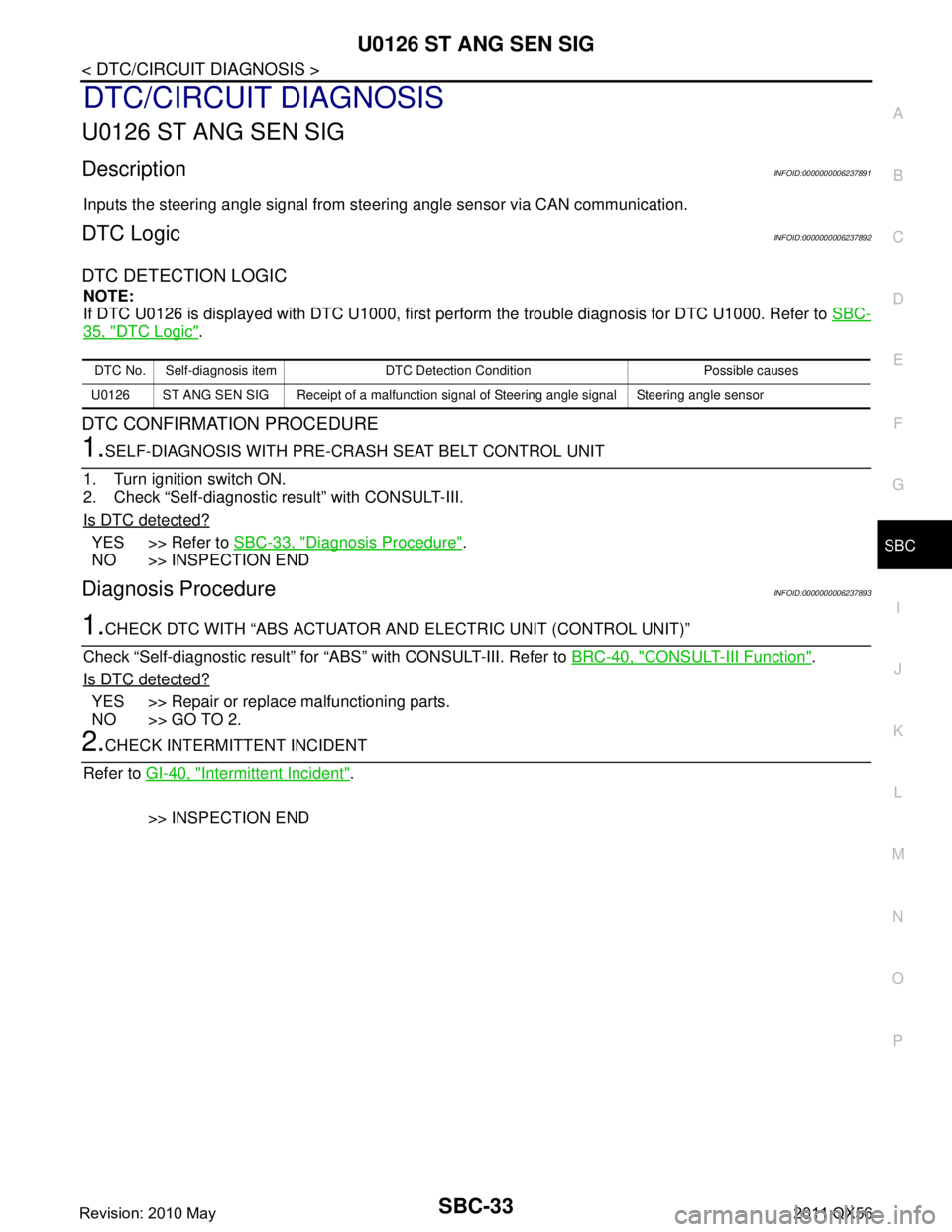
U0126 ST ANG SEN SIGSBC-33
< DTC/CIRCUIT DIAGNOSIS >
C
DE
F
G
I
J
K L
M A
B
SBC
N
O P
DTC/CIRCUIT DIAGNOSIS
U0126 ST ANG SEN SIG
DescriptionINFOID:0000000006237891
Inputs the steering angle signal from steering angle sensor via CAN communication.
DTC LogicINFOID:0000000006237892
DTC DETECTION LOGIC
NOTE:
If DTC U0126 is displayed with DTC U1000, first per form the trouble diagnosis for DTC U1000. Refer to SBC-
35, "DTC Logic".
DTC CONFIRMATION PROCEDURE
1.SELF-DIAGNOSIS WITH PRE-CRASH SEAT BELT CONTROL UNIT
1. Turn ignition switch ON.
2. Check “Self-diagnostic result” with CONSULT-III.
Is DTC detected?
YES >> Refer to SBC-33, "Diagnosis Procedure".
NO >> INSPECTION END
Diagnosis ProcedureINFOID:0000000006237893
1.CHECK DTC WITH “ABS ACTUATOR AND ELECTRIC UNIT (CONTROL UNIT)”
Check “Self-diagnostic result” for “ABS” with CONSULT-III. Refer to BRC-40, "
CONSULT-III Function".
Is DTC detected?
YES >> Repair or replace malfunctioning parts.
NO >> GO TO 2.
2.CHECK INTERMITTENT INCIDENT
Refer to GI-40, "
Intermittent Incident".
>> INSPECTION END
DTC No. Self-diagnosis item DTC Detection Condition Possible causes
U0126 ST ANG SEN SIG Receipt of a malfunction signal of Steering angle signal Steering angle sensor
Revision: 2010 May2011 QX56
Page 4331 of 5598
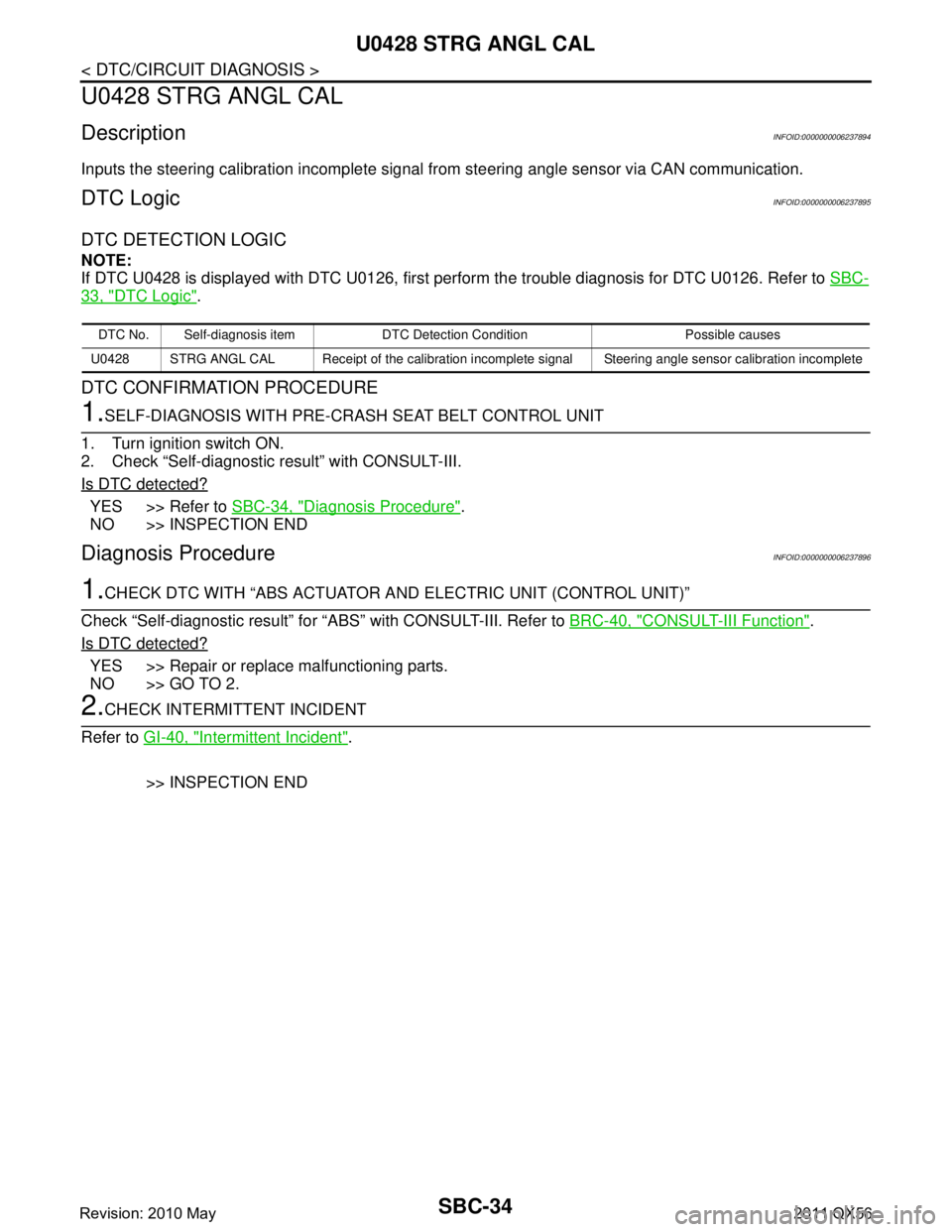
SBC-34
< DTC/CIRCUIT DIAGNOSIS >
U0428 STRG ANGL CAL
U0428 STRG ANGL CAL
DescriptionINFOID:0000000006237894
Inputs the steering calibration incomplete signal from steering angle sensor via CAN communication.
DTC LogicINFOID:0000000006237895
DTC DETECTION LOGIC
NOTE:
If DTC U0428 is displayed with DTC U0126, first perform the trouble diagnosis for DTC U0126. Refer to SBC-
33, "DTC Logic".
DTC CONFIRMATION PROCEDURE
1.SELF-DIAGNOSIS WITH PRE-CRASH SEAT BELT CONTROL UNIT
1. Turn ignition switch ON.
2. Check “Self-diagnostic result” with CONSULT-III.
Is DTC detected?
YES >> Refer to SBC-34, "Diagnosis Procedure".
NO >> INSPECTION END
Diagnosis ProcedureINFOID:0000000006237896
1.CHECK DTC WITH “ABS ACTUATOR A ND ELECTRIC UNIT (CONTROL UNIT)”
Check “Self-diagnostic result” for “ABS” with CONSULT-III. Refer to BRC-40, "
CONSULT-III Function".
Is DTC detected?
YES >> Repair or replace malfunctioning parts.
NO >> GO TO 2.
2.CHECK INTERMITTENT INCIDENT
Refer to GI-40, "
Intermittent Incident".
>> INSPECTION END
DTC No. Self-diagnosis item DTC Detection Condition Possible causes
U0428 STRG ANGL CAL Receipt of the calibration incomplete signal Steering angle sensor calibration incomplete
Revision: 2010 May2011 QX56
Page 4332 of 5598
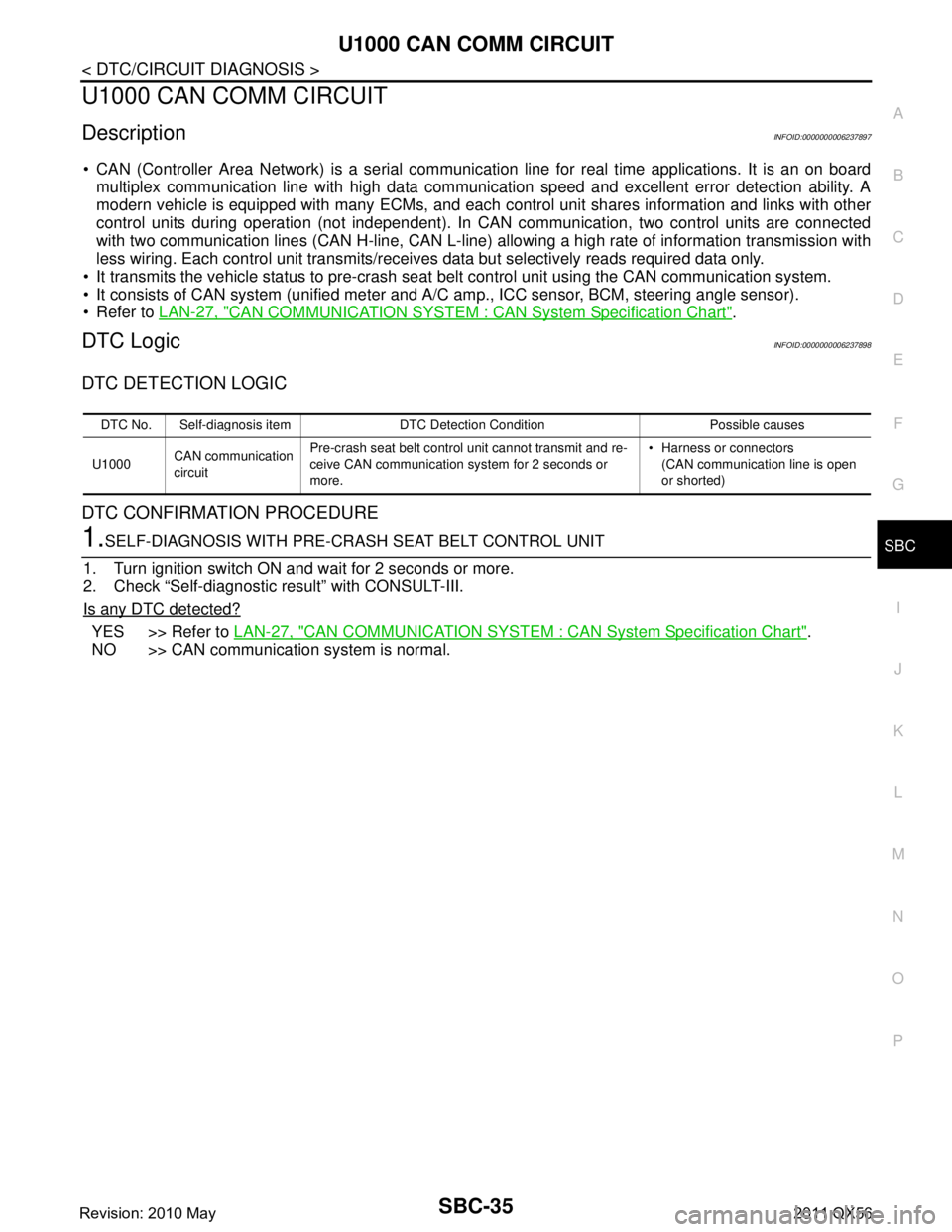
U1000 CAN COMM CIRCUITSBC-35
< DTC/CIRCUIT DIAGNOSIS >
C
DE
F
G
I
J
K L
M A
B
SBC
N
O P
U1000 CAN COMM CIRCUIT
DescriptionINFOID:0000000006237897
CAN (Controller Area Network) is a serial communica tion line for real time applications. It is an on board
multiplex communication line with high data communication speed and excellent error detection ability. A
modern vehicle is equipped with many ECMs, and each cont rol unit shares information and links with other
control units during operation (not independent). In CA N communication, two control units are connected
with two communication lines (CAN H-line, CAN L-line) allowing a high rate of information transmission with
less wiring. Each control unit transmits/receive s data but selectively reads required data only.
It transmits the vehicle status to pre-crash seat belt control unit using the CAN communication system.
It consists of CAN system (unified meter and A/ C amp., ICC sensor, BCM, steering angle sensor).
Refer to LAN-27, "
CAN COMMUNICATION SYSTEM : CA N System Specification Chart".
DTC LogicINFOID:0000000006237898
DTC DETECTION LOGIC
DTC CONFIRMATION PROCEDURE
1.SELF-DIAGNOSIS WITH PRE-CRASH SEAT BELT CONTROL UNIT
1. Turn ignition switch ON and wait for 2 seconds or more.
2. Check “Self-diagnostic result” with CONSULT-III.
Is any DTC detected?
YES >> Refer to LAN-27, "CAN COMMUNICATION SYSTEM : CA N System Specification Chart".
NO >> CAN communication system is normal.
DTC No. Self-diagnosis item DTC Detection Condition Possible causes
U1000 CAN communication
circuit Pre-crash seat belt control unit cannot transmit and re-
ceive CAN communication system for 2 seconds or
more. Harness or connectors
(CAN communication line is open
or shorted)
Revision: 2010 May2011 QX56
Page 4333 of 5598
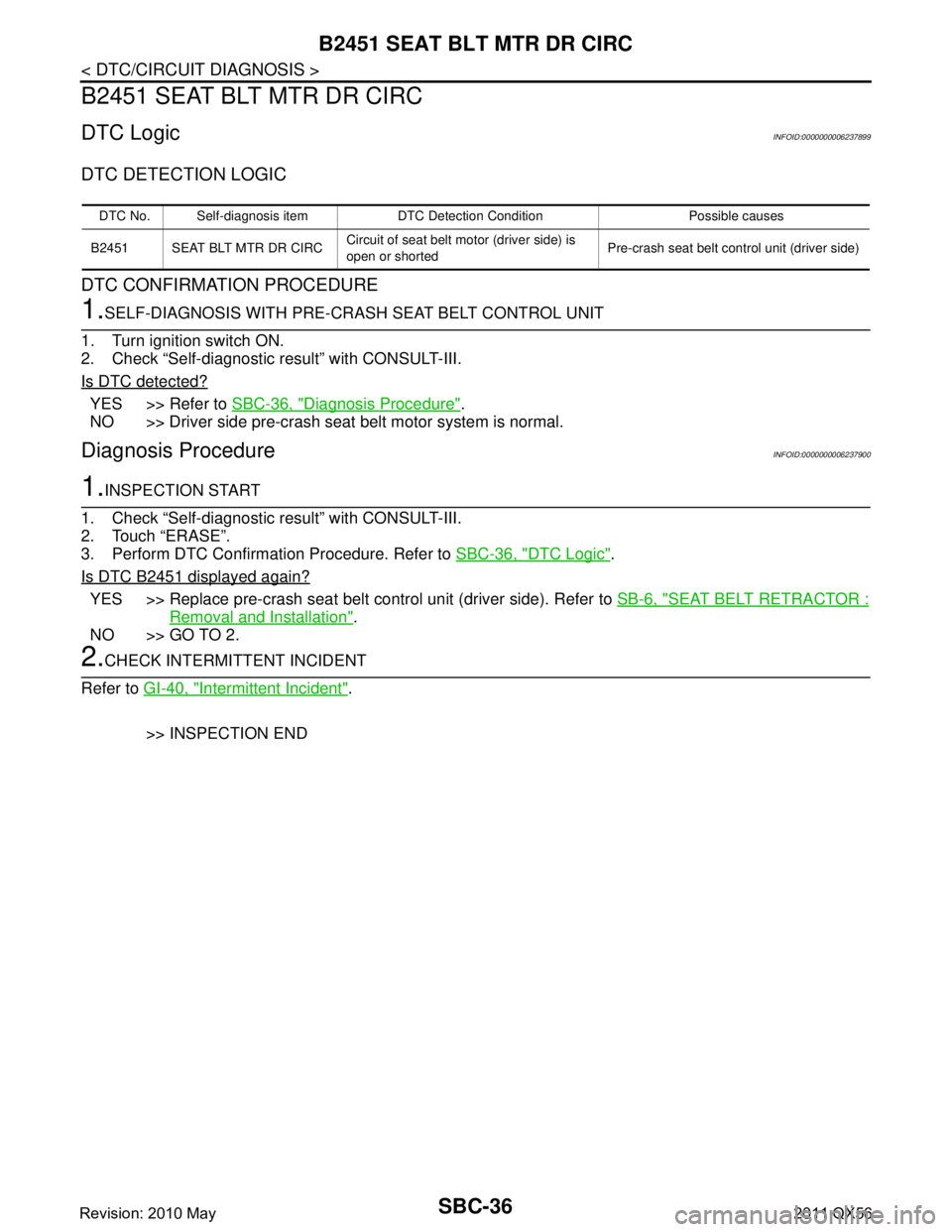
SBC-36
< DTC/CIRCUIT DIAGNOSIS >
B2451 SEAT BLT MTR DR CIRC
B2451 SEAT BLT MTR DR CIRC
DTC LogicINFOID:0000000006237899
DTC DETECTION LOGIC
DTC CONFIRMATION PROCEDURE
1.SELF-DIAGNOSIS WITH PRE-CRASH SEAT BELT CONTROL UNIT
1. Turn ignition switch ON.
2. Check “Self-diagnostic result” with CONSULT-III.
Is DTC detected?
YES >> Refer to SBC-36, "Diagnosis Procedure".
NO >> Driver side pre-crash seat belt motor system is normal.
Diagnosis ProcedureINFOID:0000000006237900
1.INSPECTION START
1. Check “Self-diagnostic result” with CONSULT-III.
2. Touch “ERASE”.
3. Perform DTC Confirmation Procedure. Refer to SBC-36, "
DTC Logic".
Is DTC B2451 displayed again?
YES >> Replace pre-crash seat belt control unit (driver side). Refer to SB-6, "SEAT BELT RETRACTOR :
Removal and Installation".
NO >> GO TO 2.
2.CHECK INTERMITTENT INCIDENT
Refer to GI-40, "
Intermittent Incident".
>> INSPECTION END
DTC No. Self-diagnosis item DTC Detection Condition Possible causes
B2451 SEAT BLT MTR DR CIRC Circuit of seat belt
motor (driver side) is
open or shorted Pre-crash seat belt control unit (driver side)
Revision: 2010 May2011 QX56